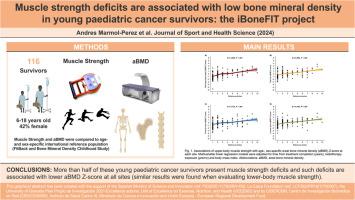当前位置:
X-MOL 学术
›
J. Sport Health Sci.
›
论文详情
Our official English website, www.x-mol.net, welcomes your
feedback! (Note: you will need to create a separate account there.)
Muscle strength deficits are associated with low bone mineral density in young pediatric cancer survivors: The iBoneFIT project
Journal of Sport and Health Science ( IF 9.7 ) Pub Date : 2024-01-12 , DOI: 10.1016/j.jshs.2024.01.003 Andres Marmol-Perez 1 , Jose J Gil-Cosano 2 , Esther Ubago-Guisado 3 , Francisco J Llorente-Cantarero 4 , Juan Francisco Pascual-Gázquez 5 , Kirsten K Ness 6 , Vicente Martinez-Vizcaino 7 , Jonatan R Ruiz 8 , Luis Gracia-Marco 8
Journal of Sport and Health Science ( IF 9.7 ) Pub Date : 2024-01-12 , DOI: 10.1016/j.jshs.2024.01.003 Andres Marmol-Perez 1 , Jose J Gil-Cosano 2 , Esther Ubago-Guisado 3 , Francisco J Llorente-Cantarero 4 , Juan Francisco Pascual-Gázquez 5 , Kirsten K Ness 6 , Vicente Martinez-Vizcaino 7 , Jonatan R Ruiz 8 , Luis Gracia-Marco 8
Affiliation

|
Pediatric cancer survivors are at increased risk of muscle weakness and low areal bone mineral density (aBMD). However, the prevalence of muscle strength deficits is not well documented, and the associations of muscle strength with aBMD are unknown in this population. Therefore, this study aimed to investigate the prevalence of upper- and lower-body muscle strength deficits and to examine the associations of upper- and lower-body muscle strength with age-, sex, and race-specific aBMD -scores at the total body, total hip, femoral neck, and lumbar spine. This cross-sectional study included 116 pediatric cancer survivors (12.1 ± 3.3 years old, mean ± SD; 42.2% female). Upper- and lower-body muscle strength were assessed by handgrip and standing long jump test, respectively. Dual‑energy X‑ray absorptiometry was used to measure aBMD (g/cm). Associations between muscle strength and aBMD were evaluated in multivariable linear regression models. Logistic regression was used to evaluate the contribution of muscle strength (1-decile lower) to the odds of having low aBMD (-score ≤ 1.0). All analyses were adjusted for time from treatment completion, radiotherapy exposure, and body mass index. More than one-half of survivors were within the 2 lowest deciles for upper- (56.9%) and lower- body muscle strength (60.0%) in comparison to age- and sex-specific reference values. Muscle strength deficits were associated with lower aBMD -scores at all sites ( = 0.133–0.258, = 0.001–0.032). Each 1-decile lower in upper-body muscle strength was associated with 30%–95% higher odds of having low aBMD -scores at all sites. Each 1-decile lower in lower-body muscle strength was associated with 35%–70% higher odds of having low aBMD -scores at total body, total hip, and femoral neck. Muscle strength deficits are prevalent in young pediatric cancer survivors, and such deficits are associated with lower aBMD -scores at all sites. These results suggest that interventions designed to improve muscle strength in this vulnerable population may have the added benefit of improving aBMD.
中文翻译:

年轻儿科癌症幸存者的肌肉力量缺陷与骨矿物质密度低有关:iBoneFIT 项目
小儿癌症幸存者出现肌肉无力和面骨矿物质密度 (aBMD) 低的风险增加。然而,肌肉力量缺陷的患病率并没有得到很好的记录,并且肌肉力量与 aBMD 之间的关系在该人群中也是未知的。因此,本研究旨在调查上半身和下半身肌肉力量缺陷的患病率,并检查上半身和下半身肌肉力量与年龄、性别和种族特定的全身 aBMD 分数的关系。 、全髋、股骨颈和腰椎。这项横断面研究包括 116 名儿科癌症幸存者(12.1 ± 3.3 岁,平均值 ± 标准差;42.2% 为女性)。分别通过握力和立定跳远测试评估上半身和下半身的肌肉力量。采用双能X射线吸收法测量aBMD(g/cm)。在多变量线性回归模型中评估肌肉力量和 aBMD 之间的关联。使用逻辑回归来评估肌肉力量(低 1 十分位)对 aBMD 较低(-score ≤ 1.0)的几率的影响。所有分析均根据治疗完成时间、放射治疗暴露和体重指数进行调整。与特定年龄和性别的参考值相比,超过一半的幸存者上半身肌肉力量 (56.9%) 和下半身肌肉力量 (60.0%) 处于 2 个最低十分位数之内。肌肉力量缺陷与所有部位较低的 aBMD 分数相关(= 0.133–0.258,= 0.001–0.032)。上半身肌肉力量每降低 1 十分之一,所有部位的 aBMD 分数降低的几率就会增加 30%–95%。下半身肌肉力量每降低 1 十分之一,全身、总髋部和股骨颈 aBMD 得分较低的几率就会增加 35%–70%。 年轻儿科癌症幸存者普遍存在肌肉力量缺陷,这种缺陷与所有部位的 aBMD 评分较低有关。这些结果表明,旨在提高这一弱势群体肌肉力量的干预措施可能具有改善 aBMD 的额外好处。
更新日期:2024-01-12
中文翻译:

年轻儿科癌症幸存者的肌肉力量缺陷与骨矿物质密度低有关:iBoneFIT 项目
小儿癌症幸存者出现肌肉无力和面骨矿物质密度 (aBMD) 低的风险增加。然而,肌肉力量缺陷的患病率并没有得到很好的记录,并且肌肉力量与 aBMD 之间的关系在该人群中也是未知的。因此,本研究旨在调查上半身和下半身肌肉力量缺陷的患病率,并检查上半身和下半身肌肉力量与年龄、性别和种族特定的全身 aBMD 分数的关系。 、全髋、股骨颈和腰椎。这项横断面研究包括 116 名儿科癌症幸存者(12.1 ± 3.3 岁,平均值 ± 标准差;42.2% 为女性)。分别通过握力和立定跳远测试评估上半身和下半身的肌肉力量。采用双能X射线吸收法测量aBMD(g/cm)。在多变量线性回归模型中评估肌肉力量和 aBMD 之间的关联。使用逻辑回归来评估肌肉力量(低 1 十分位)对 aBMD 较低(-score ≤ 1.0)的几率的影响。所有分析均根据治疗完成时间、放射治疗暴露和体重指数进行调整。与特定年龄和性别的参考值相比,超过一半的幸存者上半身肌肉力量 (56.9%) 和下半身肌肉力量 (60.0%) 处于 2 个最低十分位数之内。肌肉力量缺陷与所有部位较低的 aBMD 分数相关(= 0.133–0.258,= 0.001–0.032)。上半身肌肉力量每降低 1 十分之一,所有部位的 aBMD 分数降低的几率就会增加 30%–95%。下半身肌肉力量每降低 1 十分之一,全身、总髋部和股骨颈 aBMD 得分较低的几率就会增加 35%–70%。 年轻儿科癌症幸存者普遍存在肌肉力量缺陷,这种缺陷与所有部位的 aBMD 评分较低有关。这些结果表明,旨在提高这一弱势群体肌肉力量的干预措施可能具有改善 aBMD 的额外好处。











































 京公网安备 11010802027423号
京公网安备 11010802027423号